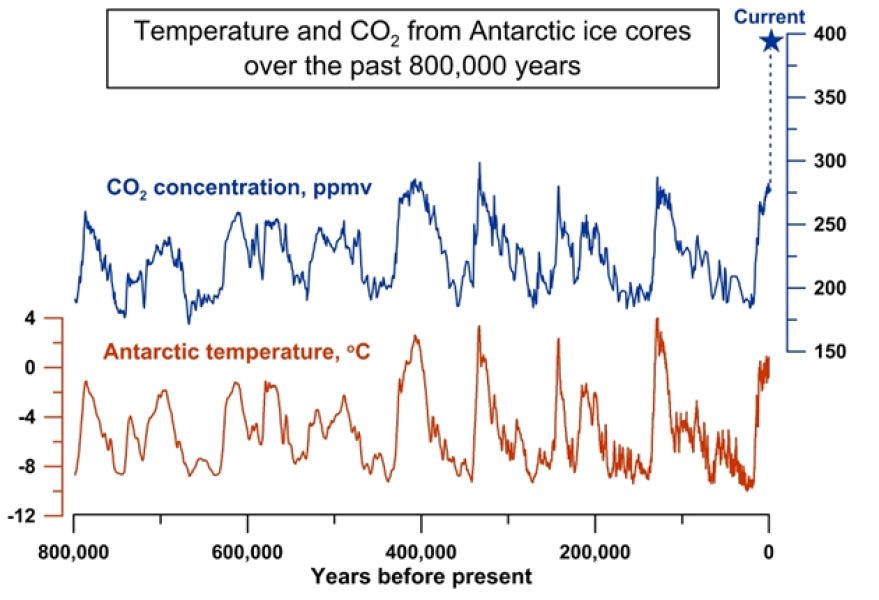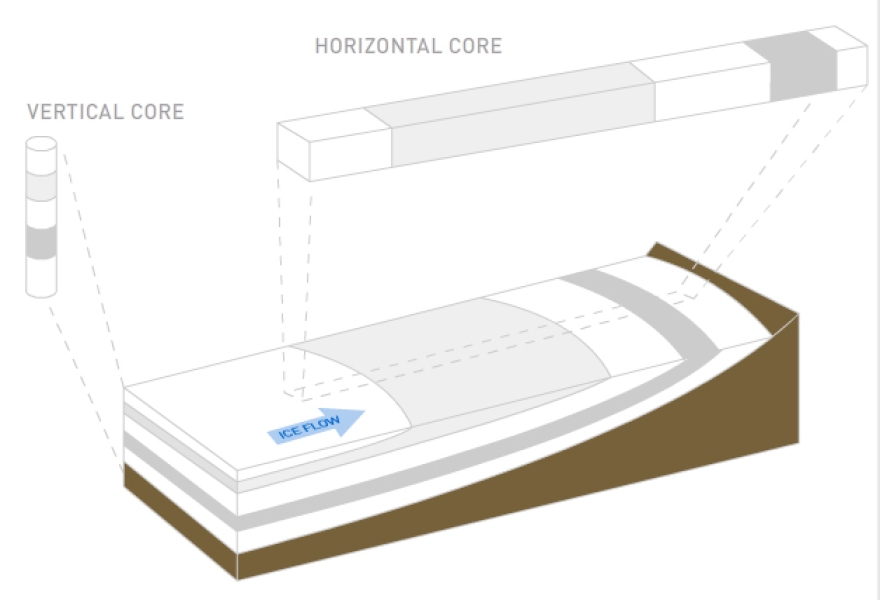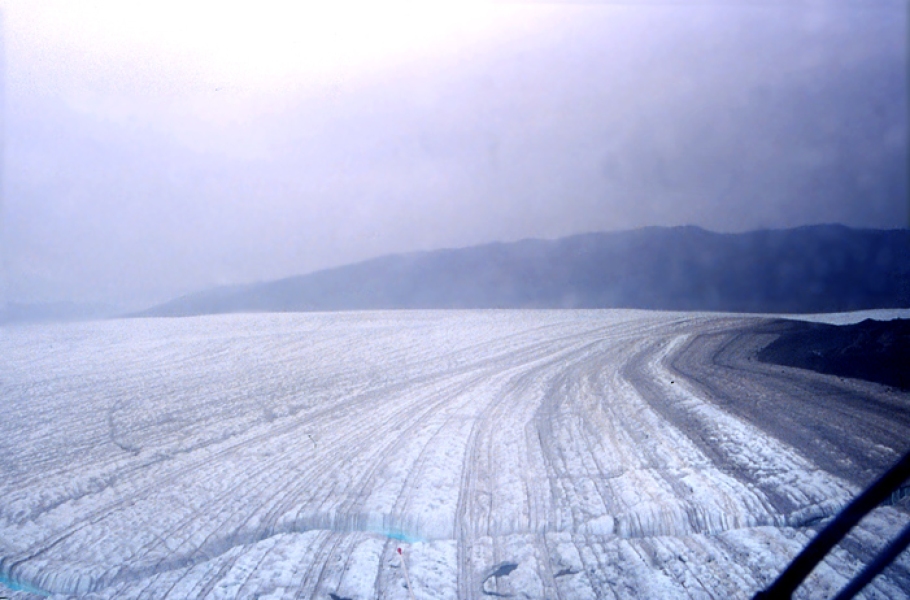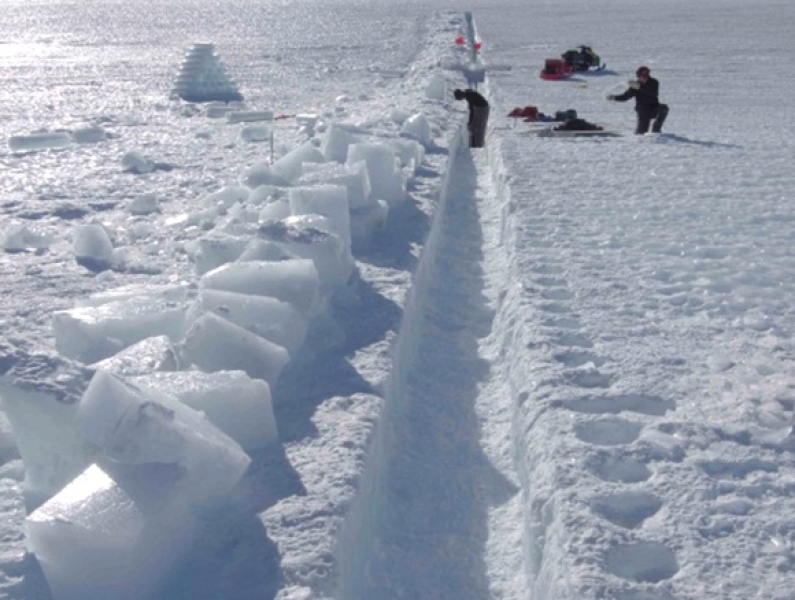Methane is a powerful greenhouse gas, with natural sources such as wetlands and permafrost which release more methane in warmer and wetter climates.
By analysing air trapped in ancient ice we can see how carbon sinks responded to warming periods in the past, to help predict how similar sources will amplify the warming from modern greenhouse gas emissions.
Risk and opportunity
Since the industrial revolution human activity has increased greenhouse gases (GHGs) to well beyond the natural range for the last 800,000 years. We can see this natural range in air trapped in ice cores drilled out of Antarctic glaciers. Each successive winter snowfall leaves bands, such as tree rings, for each year, until the lowermost layers get compressed into ice and trap air in tiny bubbles. This air is preserved and can be dated using ash layers from historic volcanic eruptions or glaciological modelling. The air can then be extracted and analysed to determine the levels of the GHGs methane CH4, carbon dioxide CO2 and nitrous oxide N2O in the atmosphere from that time.
Over the last few hundred thousand years ice ages have ended in periods of rapid warming, and ice cores provide evidence of the close relationship between temperatures and the concentrations of GHGs .
At the end of the last ice age methane levels responded to the abrupt warming with strong concentration increases. What sources released this extra methane? Understanding this will help us to understand how modern methane sources, such as permafrost and methane clathrates, will respond to anthropogenic warming, amplifying climate change in a feedback mechanism. Similar studies can be made for CO2. Together this helps us to predict what warming will result from different GHG concentrations, so that safe levels can be identified.
We need to answer these questions:
- how sensitive is the climate to GHG variations on human time scales?
- what temperature changes are likely to be caused by current and future GHG levels?
- how quickly do GHG sources and sinks respond to temperature changes?
- what feedbacks will trigger further greenhouse gas emissions in a warming world?
The approach
Ice cores provide the only way to analyse the atmosphere before direct measurements began 50 years ago. They provide a record of the changes in atmospheric composition back into the ice ages, and are indispensable for studying the connection between climate and GHG concentrations. Some ice core programmes have focused on long term records (e.g. EPICA 820,000 years, Vostok 450,000 years) drilling over 3 km down into the Antarctic ice.
Analysis of the air from these ice cores will resolve changes in atmospheric composition and the climate over a long scale. However, the sample volumes are limited due to the logistical challenges of drilling such long ice cores, and the small diameter of the cores (10-12cm), which restricts the amount of ice available for each analysis.
Find out how we analyse these samples with an instrument know as a mass spectrometer.
Different sources of greenhouse gases have different isotopic signatures, due to the way carbon 12 and carbon 13 atoms change the mass of molecules. This affects how they behave in physical and biological processes, such as photosynthesis. Depending upon what sources have contributed to the CO2 and CH4 in the atmosphere, the overall ratios of 12C/13C in CO2 and CH4 will change, telling us where these extra greenhouse gases have most likely come from.
However, these changes are very small and cannot be measured with sufficient precision in the very small quantities of air collected from conventional ice cores. The Taylor Glacier in the Dry Valleys in Antarctica provides an opportunity to collect much larger samples of ancient ice. Due to the local geography, ice 10,000 to 100,000 years old is being brought to the surface (see fig 3) so that samples that would normally be buried by hundreds of meters of ice can be collected from the glacier surface. NIWA scientists supported by a Marsden Grant have recently travelled to Antarctica to collect samples that span the end of the last ice age.
Video: "Back to the Future: Horizontal Ice Coring in Antarctica"
The result
Previous work in collaboration with American and Canadian scientists (Scripps Institution of Oceanography; University of Rochester; Oregon State University and University of Victoria, Canada) has established that methane released during a time of rapid warming at the end of the last ice age was likely to have been released by melting permafrost and wildfires.
Ice cores from the Taylor glacier are now being prepared for analysis at the NZ National Ice Core Facility. The sample contain air that is between 10,000 and 20,000 years old. They will be used to verify the previous results and study whether other warming periods show similar patterns.
The additional information gained from our unique multiple-species approach will provide additional constraints on past climate change interpretations, specifically the role of the ocean, atmosphere, and the terrestrial biosphere in GHG variations. This will help to identify how sensitive our climate really is to such changes. This knowledge will be critical in evaluating the response of Earth's future climate to increasing GHG concentrations.







